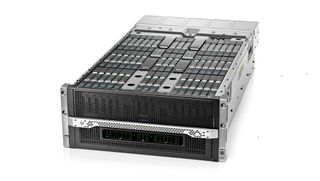What are the prospects for HP's Moonshot servers?
Aimed at fighting off low cost, non-proprietary systems

HP is trying to grab a slice of the high density computing market with a proprietary server design called Moonshot. The company describes Moonshot as "the world's first software defined server, designed and tailored for specific workloads."
To understand what this is, it's important to be clear about what it is not. HP's use of the term "software defined" has nothing to do with the current trend towards software defined networking (SDN) and software defined storage – two technologies that rely on virtualisation.
"When we use the term software, we are talking about applications," explains Paul Morgan, Hyperscale Business Manager at HP. "Rather than using generic rack or blade servers, with Moonshot we design server cartridges to run particular applications."
This promises to provide savings from lower power usage and higher utilisation in data centres; and with a competitive market these could well be passed on to businesses of all sizes that use the services.
Processor neutral
That means a web serving cartridge will be different from a back end database cartridge or a big data analysis cartridge. The Moonshot system is processor neutral, and companies will be able to choose the most appropriate processor – x86, ARM, Intel, AMD or whatever – for a given application along with the most appropriate storage and memory configuration.
HP's first production offering is a cartridge with low powered Intel dual core Atom S1200 chips designed for web serving and simple content delivery, but Morgan expects that new cartridges will be released on a cycle of about four to five months. The cartridges themselves are about the size of PCI Express cards, and each one can host either one or four servers.
Moonshot cartridges slot in to a proprietary 4.3U Moonshot chassis that includes traditional components including the fabric, HP Integrated Lights-Out (iLo) management, power supply and cooling fans. Morgan says that a full chassis of 45 low power servers will use just 1-2 KW of power.
Are you a pro? Subscribe to our newsletter
Sign up to the TechRadar Pro newsletter to get all the top news, opinion, features and guidance your business needs to succeed!
"That means there will be a significant cost saving in both space and power over conventional server installations," he says. A full rack can support up to 1,800 densely packed Moonshot servers.
Despite the high level of customisation, Morgan says each cartridge will be cost-effective for the companies that buy them because they will have the resources to do exactly what's needed of them – no more and no less.
Alternative path
The Moonshot concept is interesting because Facebook, Google and other companies with a massive internet presence have taken a very different approach to coping with the cost, space and power requirements of large numbers of servers.
Facebook, for example, has gone back to its hacker roots to design a low cost server. The designs have been handed over to the Open Compute Project (OCP) Foundation, a non-profit organisation whose board includes representatives from companies like Intel, Rackspace, Goldman Sachs and Arista Networks, and of course Facebook.
The foundation has formalised Facebook's designs into OCP specifications, which are freely available for anyone to suggest improvements. The result is low cost, no-frills compute units which pack plenty of computing power.
The principal behind the OCP server designs is to avoid the "gratuitous differentiation" that most vendors incorporate into their products to justify their high prices, according to Frank Frankovsky, Facebook's vice president of hardware design and supply chain. This includes proprietary management features that some vendors supply, but which only work in homogeneous server environments.
"Proprietary management wreaks havoc in environments like ours," explains Frankovsky.
OCP standards-compliant servers are mostly manufactured in the Far East and sold direct to companies like Facebook at wafer thin margins. They are also available to much smaller companies that want to take advantage of the low cost of the servers, and don't mind sacrificing the "gratuitous differentiation" as a quid pro quo.
